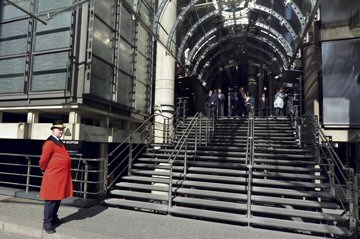Coverholders and Risk Takers
What is it? And why does it exist?
Over the past 100-plus years, our country has seen its share of catastrophes. Lloyd’s’ response to these disasters has both solidified its reputation in the insurance industry and helped shape the risk modeling and assessment practices in use today.
Ask domestic insurance agents to tell you about Lloyd’s of London and you’ll get a diverse array of responses. Some will say it specializes solely in unique and hard-to-place risks (remember the famous story about insuring Betty Grable’s legs?). Others will say the market is not much of a factor in this country. A few might not even venture an opinion.
It’s not a stretch to say that Lloyd’s is an enigma for many U.S.-based agents. In this article we will try to demystify this unique market.
In reality, Lloyd’s’ of London has been a major force in this country for well over a century. Almost 41% of Lloyds’ global annual premium comes from the United States. It’s the largest surplus lines insurer in the country, and it’s the largest non-domiciled reinsurer. All told, Lloyd’s premium generated in the U.S. in 2015 exceeded $15 billion.
Few would argue that Lloyd’s is the oldest and most recognized insurance brand in the world. Unlike most of its colleagues in the industry, it’s not an insurance company. Rather it’s a corporate body governed by regulations passed through several acts of Parliament that date back to 1871.
It operates as a partially mutualized marketplace within which multiple financial backers, grouped in syndicates, come together to take risk. These underwriters are a collection of both corporations and private individuals (traditionally known as “names”). For you classic movie buffs out there, see Lloyd’s of London starring Tyrone Power. The film was released in 1936.
Okay, so now we know what Lloyd’s is. The next question would be: Why would a U.S. agent want to do business with it? In my mind, there are at least four good reasons, which we’ll explore below.
Innovative approach to risk—The Lloyd’s of London market can trace its roots back to 1686, when marine insurance was being written in Edward Lloyd’s coffee house. Over 330 years’ worth of experience can provide some unique “outside the box” perspectives on evaluating risks.
Many traditional insurers either specialize in specific lines of business or are governed by a single corporate underwriting philosophy. The coverage forms used by these insurers are predesigned based on their target audiences. Conversely, Lloyd’s is made up of 84 different syndicates (this number is subject to change); each syndicate possesses its own unique risk appetite. Policy wordings are tailored to address the specific needs of each submission.
Here are some examples of how Lloyd’s innovation has shaped the insurance industry: The market was the first to create policies for motor, aviation, and space risks. Also, its underwriters pioneered the development of both directors and officers and cyber liability coverages—products that now are considered to be standard offerings for agents.
Track record of paying claims—Over the past 100-plus years, our country has seen its share of catastrophes. Lloyd’s’ response to these disasters has both solidified its reputation in the insurance industry and helped shape the risk modeling and assessment practices in use today.
Let’s look at an example. On April 18, 1906, an earthquake registering 8.25 on the Richter scale devastated San Francisco. The phenomenon triggered uncontrollable fires lasting three days. More than 3,000 people perished; nearly half of the city’s population was homeless. Direct quake losses totaled $24 million and fires led to another $500 million, akin to over $10 billion in today’s dollars.
British insurers paid out more than one-fifth of these total claims. A leading Lloyd’s underwriter famously instructed his San Francisco agent to “pay all of our policyholders in full, irrespective of the terms of their policies.”
Here’s a more recent example: In August 2005, Hurricane Katrina devastated the Gulf Coast. It was one of the costliest national disasters in the history of the United States and one of the five deadliest hurricanes. Lloyd’s responded quickly to the catastrophe, sending thousands of loss adjusters to the region, paying billions of dollars in claims, and donating millions of dollars in relief funds.
Over the last five years Lloyd’s has paid $30 billion in claims for policies written in the United States.
Flexibility to handle any risk—The vast majority of U.S. business generated through Lloyd’s of London is written on a surplus lines basis. Use of this kind of paper affords the flexibility to react quickly to the dynamic nature of the marketplace. Instituting changes on an admitted form—with the requirements of individual state filings and approvals—often proves to be a much more time-consuming process.
Some within the retail agent community are concerned about the security of nonadmitted paper. They operate under the misconception that surplus lines writers are not regulated. In fact, every insurer must receive the approval of an individual state insurance department before it can write business in that jurisdiction.
Admitted carriers are licensed by the states; nonadmitted insurers are “white-listed.” To be included in the “white list,” carriers must meet certain financial and regulatory criteria mandated by each jurisdiction. These requirements usually include the establishment of substantial premium reserves and/or demonstration of adequate reinsurance.
Financial stability—Several nationally recognized organizations assign grades based on the financial strength and claims paying ability of insurance entities. Syndicates operating within Lloyd’s enjoy the benefit of a single market rating given by these independent agencies. Lloyd’s is rated A (Excellent) by A.M. Best, A+ (Strong) by Standard & Poor’s, and AA- (Very Strong) by Fitch Ratings.
Some agents are wary of Lloyd’s and the nonadmitted market because their policies are not protected by state guaranty funds. Those holding that view should consider the capital structure established by Lloyd’s of London. This unique multi-layered approach—often referred to as the Chain of Security—provides excellent financial security to policyholders.
There are three “links” in the Chain of Security:
- Syndicate level assets
- Member funds at Lloyd’s
- Central assets
The first and second links are held in trust, primarily for the benefit of policyholders whose contracts are underwritten by the relevant member. Members underwrite their own accounts and are not liable for other members’ losses. The third link contains mutual assets held by the corporation; this serves as an additional safety net to meet any member’s insurance liabilities.
The next column will tackle the issue of identifying the key participants in a U.S.-London insurance transaction.
The author
Coverholders and Risk Takers is a periodic column written by principals or “early adopters” of the CHART Exchange (www.chart-exchange.com). The group’s core mission is to facilitate more U.S./London commerce via personal interaction, education, and technology. Francis J. “Frank” Huver is senior vice president and chief financial officer at Wilmington, Delaware-based Rockwood Programs, a Lloyd’s Coverholder for more than 15 years and a CHART Exchange early adopter.






